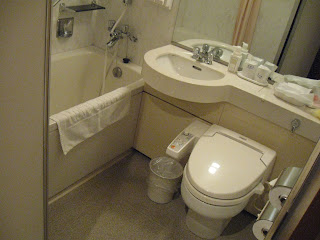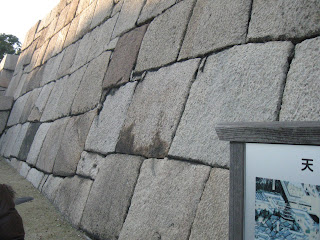We started heading towards the Arashiyama district, north west of Kyoto, with the goal of visiting Adashino Nembutsu-ji Temple.
Lashing Nembutsu-ji is a small temple, Y600 entry fee (u$7.8). The highlight is the cemetery with 8000 Buddha statues. They were originally scattered in the area, and only 100 years ago, they were found and put together inside this temple. It took about 30 minutes to visit this temple. I would recommend it to somebody with extra time. The temple lies in the outskirts of Tokyo and the ride is long. The cemetery is very interesting, but not as great as others IMO.We rode the JR train from Kyoto Station to Arashimaya, and walked from there (taking the bus would be much easier, continue reading...). The street signs and roads were confusing. There aren't many signs in English. Following a recommendation from a helpful cab driver proved to be a big mistake; he sent us on the opposite direction. Good that we weren't going to take this cab ! ... perhaps that's the reason we got those directions :-) After a long walk and after asking a few times, we ended up at Daikaku-ji temple, about 1.5 miles away from our destination. Since we lost at least an hour (on the positive we burned some calories) , we just took a quick look at Daikaku-ji grounds and took cab to Adashino Nembutsu-ji. The taxi ride took about 15 minutes and the fare was Y650 (u$8.5). Before getting in, I asked the driver how much it was going to cost.
A better way of getting to the temple is taking the bus that stops just on front of Daikaku-ji, saving a lot of time and Yens. From this point, walk to Nembutsu-ji for about 20 minutes (slightly uphill) or take a cab. But be carefull in case of walking. The roads are small and windy, and it's easy to take the wrong one. In the shop from the bus stop you can ask for directions; they have a map of the area in Japanese (better than nothing). Another consideration is that Nembutsu-ji is outside the 'white' area covered by the 1 day bus pass. Here the bus fare is variable. We took the bus to go to the next spot, Kinkaku-ji. When getting inside the bus, I took a ticket from a machine, with just a number which represents the stop where we boarded. The variable fare rate will be displayed on a monitor above the front windshield. Just pay as usual when leaving the bus.
BTW, from Adashino Nembutsu-ji we walked back to Daikaku-ji. We were very lucky to ask a Japanese guy for directions, and he happened to be going the same way and he offered to guide us. The way back wasn't easier. Our guide had to ask two or three times for directions. Good he was Japanese! It would have been very tough in English. The maps I got at the train stations didn't have enough details and didn't help here. I wouldn't try to walk the place by myself unless I got a GPS (my US phone didn't find a satellite signal even in this open area), or another guide :-).
From Daikaku-ji, we took bus 91 and changed to 59 in order to get to Kinkaku-ji (Temple of the Golden Pavilion).
 |
| Kinkaku-ji Temple of the Golden Pavilion - Kyoto |




Before taking the 91, we asked the driver where we should change bus. We went down at Yamagoe Higashicho and walked north for about one mile to the stop of bus 59. Just followed a windy road that initially seemed to go nowhere inside the hills, but after a few minutes arrived to the stop for several buses. On the way, we asked a lady to make sure we were on the right direction. When asking for directions, we always show the map obtained at the rail station. It contains names in English and Japanese. BTW, on the same road, shortly after the 91 bus stop, we found a supermarket were we got some food for lunch.
Kinkaku-ji isn't a big temple, but the garden and building are awesome. The building lies on a pond, and the water acts as a mirror. Entrance fee is Y400 (u$5.2). Two bus lines run between this temple and Kyoto station, covered by the 1 day pass.In the afternoon, we took the Shinkansen back to Kyoto. From there, took the JR train and got out at Shinjuku station. The next hotel is the Rose Garden and it is located about 7 blocks away from the station, a 10 minute walk. Use the West exit from Shinjuku station. If unsure, you can ask at the police office inside the station. They also have a map of the area.
The Rose Garden is easy to find; the police station building is across the street. I would expect this to be a very safe area :) I've been a few hours at the hotel only, but so far I'm very satisfied with the choice. It seems to have been remodeled recently, everything looks pretty new inside. The room is larger than the one from other hotels, free wired broadband Internet is available, TV with CNN in English (but only 2 channels seem to be working on the TV), it is clean and quiet.
 |
| Rose Garden Hotel - Tokyo |
 |
| Rose Garden Hotel - Tokyo |
On the other side of the train station (about 10 minutes away from the hotel), lies the active Shinjuku area. We walked around tonight, there are tons of people, shops, restaurants, and bars.
A few blocks we hit Kabukichō, Tokyo's red light district. I could see more bars and potential strip joints but not much more (e.g., no displays such as in Netherlands).
These two districts remind us that Tokyo is a huge city. This place is crowded, quite dirty, and some blocks stink. But yet, it's a very interesting place and I recommend visiting it in the evening when all the neon lights are on. It seems a safe area as the rest of Japan.
Just after midnight, while walking on a road, we heard some chanting from Buddhists monks celebrating new year:









































